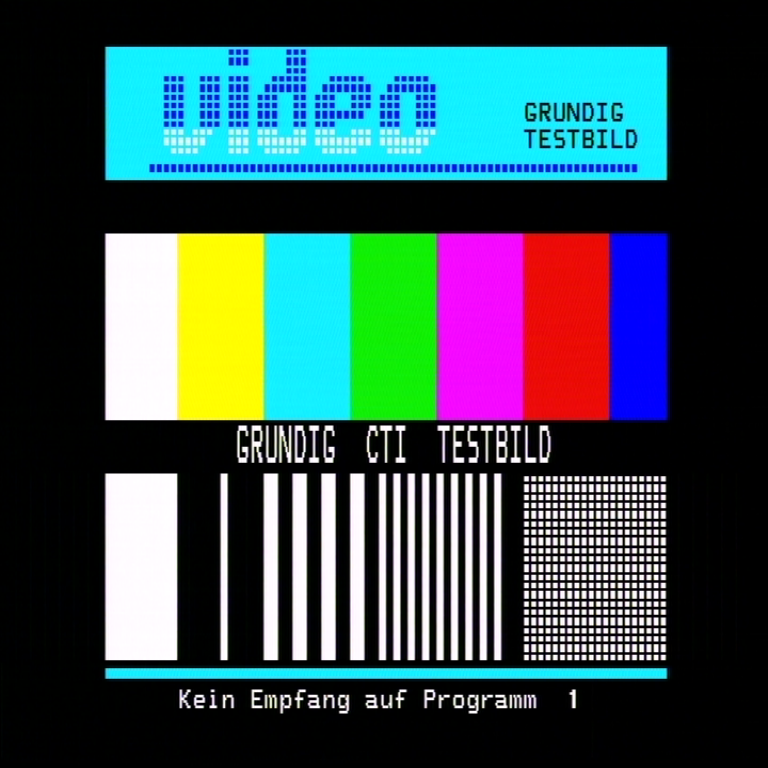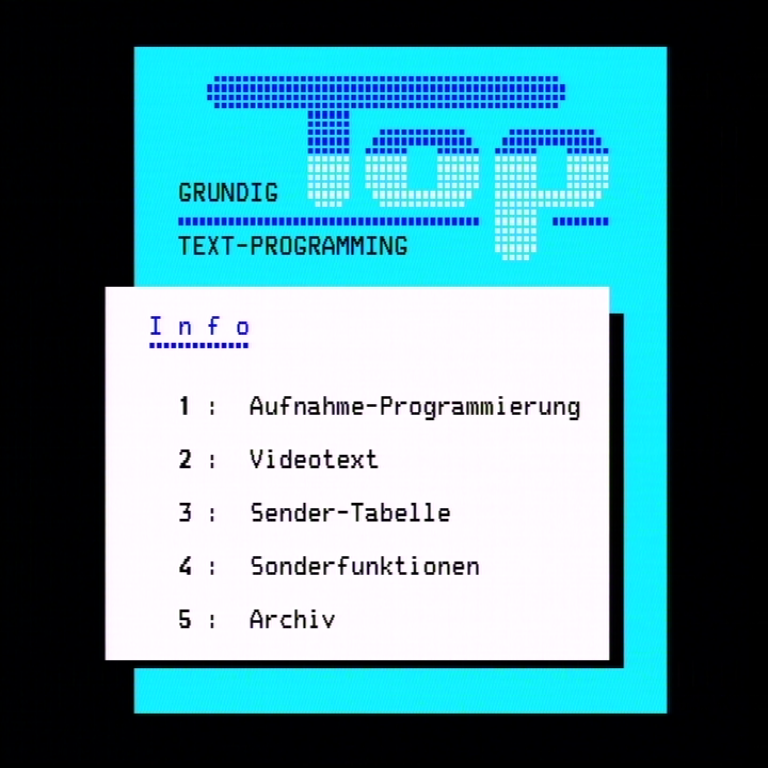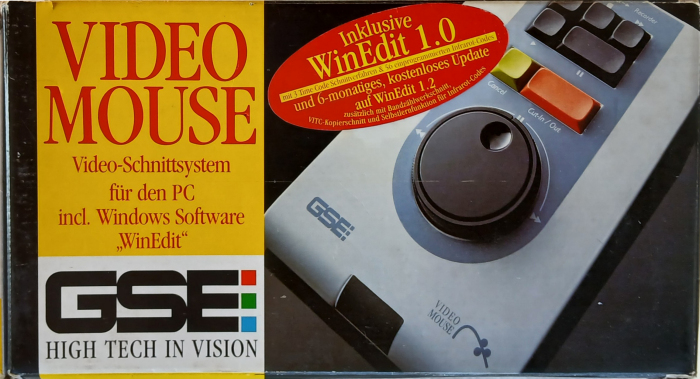QXL.WIN
<< - Back to
homepage (opens in this tab/window).
Website Extra (non QL related)
The Grundig GV 280S Video Recorder -
Some info and also
software/firmware downloads and PDF manuals
The Grundig GV280S was a high end video recorder made in Germany by Grundig
between 1991 and 1994. With a new RRP of 4,699 Deutsche Marks in 1993 (almost
£1,600 in 1993 money) it was the most expensive VCR in the Grundig range. It was
equipped with S-Video output (and input) as well as hifi sound and a number of
other features that were fairly typical of contemporary high-end VCRs.
Extraordinary features that made it stand out from most other VCRs of the time
include the built in Archive software and editing/mixing features including
creation of on-screen text and special effects. Most importantly, especially for
today's most common use of VCRs, i.e. digitising old tape recordings, is that it
has a built-in Time Base Corrector (or does it? more on that below).

At 475 x 375 x 150mm and just over 10kg in weight, it's a large machine and
looks very sleek with its glossy bevelled side panels and its fold down front
control panel. The remote control, a Grundig RP81, is also quite unusual due to
it's 3 'levels' of buttons including a keyboard and other advanced functions
that are not available on the front panel of the VCR.
The units are very well built, but after 30+ years of time, the weakest-link
causing many of them to not even turn on is usually (nearly always) the power
supply section, which is located on Chassis board I. Components that commonly
fail on the primary side tend to be the X2 class mains filter capacitors (both
of them), the TDA4605 IC, the BUK455 power FET and sometimes the electrolytic
capacitors. On the secondary side of the power supply circuitry and dotted
around the rest of the Chassis I board there are also a number of electrolytic
capacitors - in fact there are a large number of electrolytic capacitors well
distributed across all the other PCBs in the machine, but these tend to be less
critical. The capacitors on Chassis board I between where the plug-in connectors
start and the metal shield of the primary side often fail, so it's wise to
change all of them to ensure that the unit is getting smooth correct-spec power
in all the places that it requires it! The VFD display is sensitive to out of
spec voltages, resulting in partially dim characters. Note that smaller display
on the fold down flap only works when the right hand glossy plastic panel is
present, as it contains a magnet which operates a reed switch. In operation the
units do get quite warm and despite the ventilation holes on the top, I feel
that a small fan to expel warm air would have been beneficial. The technical
service manual is available online.
Software inside
The VCR incorporates microprocessors and the software to control the many
features is contained within 3x standard UV erasable EPROM ICs (2x 27C512-64Kx8
and 1x 27C256-32Kx8) mounted on 3 different circuit boards within the tightly
packed VCR confines. The software version is displayed on the VFD for a couple
of seconds when the machine is initially plugged into the mains. Software
versions 22, 23 and 26 have been seen (so I assume there are also versions 24
and 25). A 4th electronically erasable (EEPROM) 32k chip is used to store
channel name information, saved user-created text screens and the users' Archive
data for up to 700 video tapes. A second 32k EEPROM socket is provided for
expansion, in the event that 700 archive slots was insufficient. There is a PCB
mounted 3v non rechargeable battery to keep the time/date and other settings. If
mains power is disconnected and the battery is empty, the main user data is not
lost, as it is stored permanently on the EEPROM(s). The internal battery keeps
time even when depleted to 1.4v and I have seen evidence that an original
internal battery was still in use in 2005, so that's at least a 10 year
life-span (assumed with the unit always or mostly connected to mains power). If
the internal battery is replaced the VCR will require unlocking when powered on
(with the code 4934 then 'OK', which puts the unit into service mode initially
and when turned off and on again the VCR will work normally). If no internal
battery is installed the unit will show a locked state and will not respond at
all to the remote control.
Within the software the display language for the menus etc can be changed -
German is the default. Dutch, French and Italian are also offered. Interestingly
there is no option for English and I can find no evidence of the GV280S ever
being sold in an English speaking country. An English language printed manual
certainly exists (with part no. suffix -GB) which features screenshots of German
language screens - as do the manuals for the other languages.


Archive Facility
The Archive feature of the Grundig GV 280S was essentially a database stored
within the VCR. Whenever a cassette was used to record something it would prompt
the user to assign a number and name. The VCR saved the unique cassette number
to the cassette during recording and also marked separate recordings on the tape
with a graphical representation of the layout/length of the different recordings
on the tape. Each recording could also manually be given a name or in some cases
the VCR would automatically name the recording based on the teletext program
data when the recording was made. For cassettes that were purchased or not
recorded by the VCR the user could also view a graphical representation of the
content, manually assign the tape a number and manually save details of the
recordings - the only difference is that the VCR cannot read the unique number
from cassettes that it has never recorded to, because it only saves that
information during a recording and if presented with a tape that it cannot find
a number on will ask the user to manually enter its number (so e.g. pre-recorded
commercial video cassettes are never altered in any way). A search facility
allows the user to search their entire cassette collection for any string of
text, upon which the VCR displays the relevant cassette numbers so that you can
pick the correct numbered cassette and when inserted the VCR will wind to the
correct part of the tape ready to play back whatever it was you searched for.
Therefore with the Archive system, the physical cassettes on your shelf only
require a sticker or marking with the cassette number - the VCR already knows
what's on it!

Time Base Corrector
The TBC is listed as a feature in the 1993 Grundig product catalogue published
at the end of 1992 and marked as current for January 1993, but is not mentioned
in the handbook literature nor specifically in the service manual. In a dealer
issued 'product news' bi-lingual A4 4-sided flyer from one year later, dated
January 1994 the -PC model (see below) is also specced as having a TBC. The
general consensus though, is that the GV 280S doesn't actually contain a TBC, or
at least not a TBC in the proper sense and that the TBC claims in marketing
material were for something that was never included in the final product.
I
can confirm that digital captures when using the S-Video output are pretty good,
usually with a good square image, minimal, if any picture tearing and decent
colour reproduction. I have experienced audio sync issues when the
digital capture is longer than a few minutes, but that is likely to be my test
capture hard- or software, so I need to experiment further with that. There are better, later
VCRs that definitely do have a TBC, one that can be enabled or disabled at the
touch of a button, but I think the
robustness of the GV 280S and the quality of the video that it outputs do make it a useful tool for VHS digitising.
The GV 280S-PC
The GV 280S appears to have been sold under a few variations denoted by way of
suffixes to the main model number, the most common being the suffix -VPT (which
indicates 'Video Recorder Programming by Teletext'). Another variation was the
GV 280S-PC, which seems to have been launched in January 1994. The PC stands for 'Personal Computer' (obviously) and externally the
-PC model has the addition of a 9-pin serial port socket on the rear. Within the
-PC version there is another circuit board crammed inside that interfaces the
serial port with the rest of the VCR. It contains another EPROM (64k) labelled,
in the unit I have, as version GV280_D - the 'D' may just stand for Deutsch or
Deutschland. The main GV 280S software version inside my -PC model is version 26
- I have not yet tested to see if version 22 or 23 works in conjunction with the
extra PC connectivity - being older versions, they may not. The -PC model
daughterboard is made by GSE and within the EPROM code there is a version date
of 3rd August 1994 and there is also the text: "Copyright GSE-Videotechnik
Winter 1993/94".
GSE, or General Systems Electronics were fairly well-known within the early 90s
prosumer video editing scene and it would seem that Grundig enlisted their
assistance to provide a PC connection for the already advanced GV 280S VCR. I'd
love to know how much the GV280S-PC cost when new - I suspect considerably more
than the 4,699 DM base price.
The GV 280S-PC Software
A fancy VCR with PC connection capabilities is of no use without the software to
control it! This software, made available here for the first time ever (as far
as I can tell) was called WinVCR and was supplied on both 5.25" 360k and 3.5"
720k diskettes, with the same files on both disks. The software is also dated
1994 and is designed to run on Windows 3.1, but does seem to install and work
fine under Windows 95. It would not install on Windows 98SE, however the install
process simply unpacks 3 files with a resultant combined size of 493kb. With
these 3 unpacked files manually copied over, the program runs without issue on
Windows 98SE. It does not run on Windows XP or any newer version of Windows. I
have not tried it with Windows 2000.
Once up and running, the main play, pause, RWD, FFD etc functions can be
controlled from the PC. The software supports GSE RAPID Time-Codes.
Important: The remote control can be configured to control another VCR and/or a
TV. The VCR connected to the PC has to be setup to accept commands from the
remote control in Video 1 mode, or the commands from within the WinVCR software
will be ignored. The serial cable supplied has a male connection on one end and
a female connection on the other end. If you have acquired a -PC model without
the serial cable, let me know and I can provide wiring details for making a
replacement.
How many were sold?
For the most common GV280S-VPT models the
earliest serial number seen is 100,067 and the latest is 110,485, so it is
likely that the numbers started at 100,000 and that probably around 11,000 units
were sold. A late unit with serial number 109,566 had software version 23. The
-PC suffix models have a different sticker with no discernable serial number,
which could indicate that their version 26 of the software contains code
necessary for the working of the -PC model.
Useful Downloads
Main Firmware (the code included within
the 3 EPROMs, found on the Chassis I, Chassis II and Archive PCBs - with German,
Dutch, French and Italian menu options):
Grundig GV280S firmware
version 22
Grundig GV280S firmware
version 23
Grundig GV180S firmware
version 26
Firmware from the GSE PC connectivity
daughter-board, contained within the GV280S-PC model:
Grundig GV280S-PC
GSE GV280_D
Software:
The
WinVCR software supplied with the GV280S-PC
(Copy the files within the zip file into any
folder and run the WINVCR.EXE program - tested on Win3.1, Win95 and Win98SE. If
no VCR is connected it will report an error in establishing communication with
the VCR, but some features can still be accessed).
Printed Material (in PDF form):
Grundig GV280S-VPT
main manual, part 1 (English)
Grundig GV280S-VPT
main manual, part 2 (English)
Grundig GV280S-PC
info flyer for dealers (German and English)
WinVCR software
manual for the -PC model (German)
GSE-Rapid
Timecode information for the -PC model (German)
Other Contemporary Grundig Printed
Information:
1993 Product Catalogue
'Revue' (German)
1993 Product
Catalogue Supplement 'Ergänzung' (German)
1993 Product info
charts, prices etc (German)
GSE Videomouse Bonus:
GSE also sold a 'Video Mouse' device
including PC software, which enabled PC control of other suitably-equipped
contemporary VCR models. The Videomouse included a shuttle/jog unit and software
called WinEdit. The software is designed for Windows 3.1 but will probably work
in Win95 (I haven't tested it) and possibly also Win98SE. The software here is
version 1.2 and is provided as 2x 1.44mb floppy disk images.
GSE WinEdit for
Videomouse disk 1 (German)
GSE WinEdit for
Videomouse disk 2 (German)
GSE WinEdit manual as PDF
(German)

<< - Back to
homepage (opens in this tab/window).




